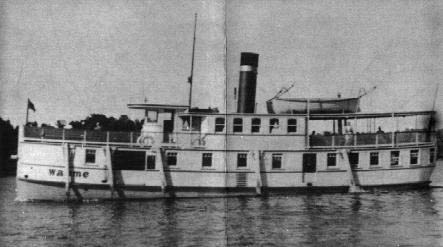Located in Lake Muskoka, the Waome Shipwreck is one of the most popular wrecks to dive in the lake. Diving just 50 feet into the water at Lake Muskoka off Keewaydin Island will carry you to the bow of the old Waome steamship. The 78-foot container, sunk in October 1934, sits upright on the lake’s bottom. Lake Muskoka’s depth and dark waters add up to the dive’s mystique.
Located between Port Carling, Ontario and Gravenhurst, Canada, Lake Muskoka is known as “cottage country”. On long weekends and during the summer months, many people flock to the “Muskokas’,” for fun in the sun and on the water.
First mention of Muskoka in any record is in 1615 and the area was inhabited by indigenous peoples, consisting primarily of the tribes of Algonquin and Huron. Early explorers came to the region like Samuel De Champlain, followed by Missionaries. The word Muskoka derives from the word of Musquakie, a chief of the Ojibwe or Chippewa tribe, which means “not easily turned back in the day of battle”. Studded with lakes and filled with rocks, the land offered an abundance of fishing, hunting, and trapping but was unfit for farming. European inhabitants largely overlooked the land of the Ojibwa people, thus settling the more prosperous area south of the Severn River.
Alexander Cockburn, named Muskoka’s “Dad”, began to bring steamers on the water, beginning with the Wenonah. Through constructing locks at Port Carling and opening a cut between Lake Rosseau and Lake Joseph at Port Sanfield, Cockburn forced the government to open the entire Muskoka lake system to navigation in 1866. The government was keen to promote production in the face of tentative farming.
Designed in a Gravenhurst ship yard, the Waome was launched in 1912 and was called MINK. She was a steel-framed wooden steamer and had length of 78′ at the keel, 14′ around her deck and 60 tonnes displaced. She was in service until 1925, then laid down for two years. The MINK was sold to Navigation Co. in June 1927, which overhauled it and closed in its upper deck to create a lounge for passengers.
On the way from Port Carling to Beaumaris, 6 October 1934, a freak wind caught Waome broadside, sending her to the bottom just west of Keewaydin Island. There were six crew members and one passenger on board. Four crew members were able to swim to Keewaydin Island and were rescued there. The remaining three were lost. The Waome is situated in Lake Muskoka, only a few hundred yards southwest of Keewaydin Island’s northern end (one of the Seven Sisters Islands) and is only accessible by boat.
This dive is recommended for experienced divers, due to the depth (rests in 70 feet) and the dark water, even during the daylight hours. You will need a light to see inside the wreck. Temporary buoys are usually on both ends of the wreck and visibility ranges from 10 to 25 feet.
Like with all Marine Historical Sites in Ontario, the Waome is the property of The Province of Ontario and it is illegal to remove any content. Fines are very hefty.







